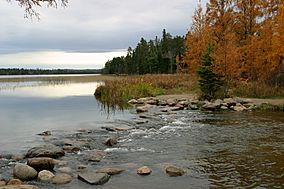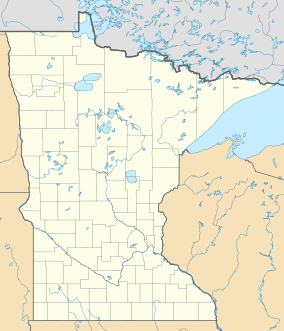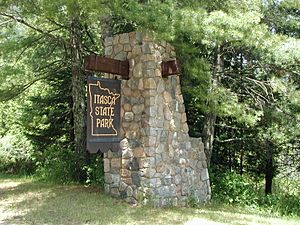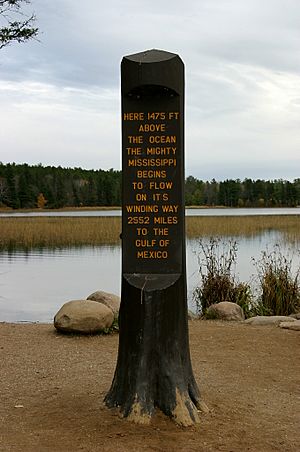Itasca State Park facts for kids
Quick facts for kids Itasca State Park |
|
|---|---|
|
IUCN Category IV (Habitat/Species Management Area)
|
|

The headwaters of the Mississippi River in Itasca State Park
|
|
| Location | Minnesota, United States |
| Area | 32,690 acres (132.3 km2) |
| Elevation | 1,558 ft (475 m) |
| Established | 1891 |
| Governing body | Minnesota Department of Natural Resources |
Itasca State Park (/aɪˈtæskə/) is a special place in Minnesota, United States. It's famous because it's where the mighty Mississippi River begins! The park covers a huge area of about 32,690 acres (132.3 km2) in northern Minnesota. It's located near the towns of Park Rapids, Minnesota and Bagley, Minnesota.
The park was created by the Minnesota Legislature on April 20, 1891. This makes it Minnesota's very first state park. It's also the second oldest state park in the entire United States, after Niagara Falls State Park. In 1832, explorer Henry Schoolcraft found that Lake Itasca was the true source of the river. Later, in 1965, the park was named a National Natural Landmark. It was also added to the National Register of Historic Places in 1973. About 500,000 people visit Itasca State Park every year.
Contents
History of Itasca State Park
Early People and the Land
Thousands of years ago, around 7,000 to 8,000 years ago, Native American hunters lived in the Itasca State Park area. They hunted wild animals like bison, deer, and moose. They would ambush these animals at watering spots and use stone-tipped spears to hunt them. You can still see a bison kill site along Wilderness Drive in the park today. It helps us understand how these early people lived.
Later, a group of people from the Woodland Period came to Lake Itasca. They built bigger, more settled communities. They also made many tools from stone, wood, and bone. You can see ancient burial mounds from this time at the Itasca Indian Cemetery.
Naming the Mississippi's Source
In 1832, an Anishinaabe guide named Ozawindib led explorer Henry Schoolcraft to the source of the Mississippi River at Lake Itasca. During this trip, Schoolcraft, with help from a missionary, created the name "Itasca." It comes from two Latin words: veritas (meaning "truth") and caput (meaning "head"). So, Itasca means "true head" or "true source."
Protecting the Forests
In the late 1800s, a historian and land surveyor named Jacob V. Brower came to the park. He wanted to confirm the exact spot where the Mississippi River began. Brower saw that the area was being quickly changed by logging. He was determined to save some of the beautiful pine forests for future generations. Because of his hard work, the state government decided to make Itasca a Minnesota State Park on April 20, 1891. It was a very close vote! Thanks to Brower and others, the park's natural beauty has been protected.
Itasca Biological Station
The Itasca Biological Station and Labs (IBSL) was started in 1909. It's one of the oldest and largest field training centers in the United States. It's a place for research and for college students to take summer classes. Students from the University of Minnesota College of Biological Sciences come here. They learn about nature and study the diverse plants and animals in the park.
Park Landscape and Lakes
Unique Terrain
Lake Itasca is the official source of the Mississippi River. This beautiful area in northern Minnesota looks much like it did naturally. Most of the park is covered with thick forests, including old red pine trees. The red pine is Minnesota's state tree. Some of these trees in Itasca are over 200 years old!
The land in Itasca is often called "knob and kettle" terrain. The "knobs" are hills made of dirt and rocks left behind by glaciers. The "kettles" are dips in the ground, often filled with water, formed when chunks of ice buried by dirt melted. About 10,000 years ago, the glaciers melted away. They left behind 157 lakes of different sizes. These lakes cover about 3,000 acres (12 km2) of Itasca State Park. The glaciers also left a thick layer of silt, clay, sand, and gravel up to 680 feet (210 m) deep. The park also has 27,500 acres (111 km2) of high land and 1,500 acres (6.1 km2) of swamp.
Plants and Animals of Itasca
Plant Life and Forests
Itasca is famous for its old-growth pine forests, almost as much as for the Mississippi headwaters. These ancient pines are some of the few left in the state. Protecting these forests was a main goal for Jacob Brower when he worked to create the park. Logging in the late 1800s and early 1900s cut down many large pine trees. Logging stopped around 1920.
People have tried to bring back the pine trees since 1902. However, it's been hard because wildfires have been stopped in the park since the 1920s. Fires are actually important for new white, red, and jack pines to grow. Fires clear the forest floor and canopy, making space for new trees. Also, too many white-tailed deer eat young pine seedlings, stopping them from growing into full trees.
Before European settlers arrived, the park had many jack pine and northern pin oak trees. Today, you can find many types of trees in Itasca. These include quaking aspen, bigtooth aspen, paper birch, red pine, and white pine. There are also mixed northern hardwoods. Aspen trees are now the most common type in the park.
The park is also home to fourteen plants that are on the state's endangered species list. These include the ram's-head lady's slipper and the bog adder's-mouth.
Animal Life
Itasca is where three different natural areas meet: pine forests, deciduous forests (trees that lose leaves), and prairie (grasslands). This mix creates homes for many different plants and animals. Over 200 types of birds live in Itasca. You might see bald eagles, loons, ducks, owls, and woodpeckers.
More than 60 types of mammals live along the park's trails. These include beavers, porcupines, black bears, and timber wolves.
The large number of white-tailed deer has caused some problems in the park. In 1998, there were about 15 to 17 deer per square mile. This is much higher than the 4 to 10 deer per square mile in similar areas. This happened because of man-made open spaces and a deer protection zone that was in place until the 1940s. Since 1940, annual deer hunts have been held to help control the deer population.
A special type of insect called the caddisfly Chilostigma itascae is only known to live in Nicollet Creek in the park.
Itasca as a National Natural Landmark
In November 1965, the area was named a National Natural Landmark. This means it's recognized as an amazing example of the nation's natural history. The park has some of the best remaining old forests of red pine, spruce-balsam fir, and maple-basswood-aspen trees. These forests are home to 141 bird species and 53 mammal species, including bald eagles.
Climate and Weather
Understanding Itasca's Weather
Itasca State Park is in northern Minnesota. Its weather can be affected by three main air masses. Cold Arctic air comes from Canada in winter. Pacific air with strong west winds moves over the area. And warm tropical air flows north from the Gulf of Mexico in summer. These different air masses greatly affect the climate around Itasca State Park.
Seasons in Itasca
In winter, it gets very cold. The average low temperature in Itasca is about −4 °F (−20 °C). There's also a lot of snow, averaging around 54.6 inches (139 cm) each year. When Arctic air mixes with heavy snow and wind, it can create strong blizzards.
In summer, the Pacific and tropical winds from the Gulf bring warm to hot temperatures. The average high in July is about 78.4 °F (25.8 °C). Sometimes, cool, dry air from Canada clashes with the moist air from the Gulf. This can cause showers and thunderstorms. The park gets about 27 inches (69 cm) of rain each year. The growing season is quite short. The first frost usually happens in late September or early October. The first frost-free days don't usually arrive until mid-May or early June.
| Climate data for Itasca State Park (1991–2020 normals, extremes 1911–present) | |||||||||||||
|---|---|---|---|---|---|---|---|---|---|---|---|---|---|
| Month | Jan | Feb | Mar | Apr | May | Jun | Jul | Aug | Sep | Oct | Nov | Dec | Year |
| Record high °F (°C) | 62 (17) |
63 (17) |
81 (27) |
96 (36) |
98 (37) |
100 (38) |
105 (41) |
101 (38) |
99 (37) |
92 (33) |
74 (23) |
59 (15) |
105 (41) |
| Mean daily maximum °F (°C) | 16.9 (−8.4) |
22.8 (−5.1) |
35.9 (2.2) |
51.0 (10.6) |
65.0 (18.3) |
74.3 (23.5) |
78.8 (26.0) |
77.4 (25.2) |
68.1 (20.1) |
52.1 (11.2) |
34.8 (1.6) |
22.2 (−5.4) |
49.9 (9.9) |
| Daily mean °F (°C) | 6.3 (−14.3) |
10.6 (−11.9) |
24.0 (−4.4) |
38.5 (3.6) |
52.2 (11.2) |
62.4 (16.9) |
66.9 (19.4) |
65.1 (18.4) |
56.2 (13.4) |
42.3 (5.7) |
26.7 (−2.9) |
13.7 (−10.2) |
38.7 (3.7) |
| Mean daily minimum °F (°C) | −4.3 (−20.2) |
−1.6 (−18.7) |
12.1 (−11.1) |
26.0 (−3.3) |
39.4 (4.1) |
50.6 (10.3) |
54.9 (12.7) |
52.7 (11.5) |
44.3 (6.8) |
32.5 (0.3) |
18.6 (−7.4) |
5.1 (−14.9) |
27.5 (−2.5) |
| Record low °F (°C) | −51 (−46) |
−52 (−47) |
−44 (−42) |
−17 (−27) |
11 (−12) |
24 (−4) |
32 (0) |
26 (−3) |
16 (−9) |
−14 (−26) |
−30 (−34) |
−47 (−44) |
−52 (−47) |
| Average precipitation inches (mm) | 0.75 (19) |
0.72 (18) |
1.22 (31) |
2.00 (51) |
3.18 (81) |
4.57 (116) |
3.53 (90) |
3.23 (82) |
3.08 (78) |
2.85 (72) |
1.32 (34) |
1.12 (28) |
27.57 (700) |
| Average snowfall inches (cm) | 9.6 (24) |
8.0 (20) |
7.8 (20) |
6.2 (16) |
0.1 (0.25) |
0.0 (0.0) |
0.0 (0.0) |
0.0 (0.0) |
0.0 (0.0) |
1.0 (2.5) |
9.1 (23) |
9.8 (25) |
51.6 (131) |
| Average precipitation days (≥ 0.01 in) | 8.8 | 7.6 | 7.5 | 8.8 | 13.3 | 13.9 | 12.8 | 10.9 | 11.9 | 11.3 | 8.8 | 10.0 | 125.6 |
| Average snowy days (≥ 0.1 in) | 6.5 | 5.9 | 3.9 | 1.9 | 0.1 | 0.0 | 0.0 | 0.0 | 0.0 | 1.0 | 4.1 | 8.2 | 31.6 |
| Source: NOAA | |||||||||||||
Fun Things to Do in Itasca
Itasca State Park offers fun activities all year round! Inside the park's main building, there's a 31-bed youth hostel. It's run by Hostelling International USA and is open to visitors of all ages.
Spring Activities
In spring, many people come for fishing. You can catch walleye, northern pike, bass, and panfish. The park is also full of beautiful wildflowers. Birding is popular as many different bird species return from their migrations.
Summer Adventures
Lake Itasca is a very popular spot in Minnesota during the summer. In 2006, almost 500,000 people visited! You can rent equipment for fishing, canoeing, boating, and kayaking. On land, you can go biking on the Heartland Trail, horseback riding, and hiking. A 9.6-mile (15.4 km) part of the North Country National Scenic Trail goes through the park. It even has three campsites for hikers.
One of the most visited spots is the headwaters of the Mississippi River. You can visit the new Mary Gibbs Visitor Center and see exhibits at the Jacob V. Brower Visitor Center. You can even walk across the rocks at the very beginning of the Mississippi River! There's also a bridge if you don't want to get your feet wet. The park also has a 100-foot (30 m) tall Aiton Heights Fire Tower that you can climb for amazing views.
Fall Colors and Trails
Fall brings beautiful colors to the park's many trees. It's a great time to bike, hike, or just take a relaxing walk on the trails. The park has 33 miles (53 km) of hiking trails to explore.
Winter Fun
In winter, people enjoy ice fishing on Lake Itasca. Snowmobilers can ride for hundreds of miles on groomed snowmobile trails. Skiers can use 30 miles (48 km) of cross country skiing trails. These trails are for both beginners and experienced skiers and are kept in great condition.
Park Buildings and History
Around Itasca State Park, you'll find many historic buildings and places to visit. These buildings were constructed over 37 years, from 1905 to 1942. They were built by workers from two Civilian Conservation Corps (CCC) camps and two Works Progress Administration (WPA) camps. The architects used a "Rustic Style" design. They often used logs because there was plenty of timber in the area.
Rustic Style Architecture
Itasca has the largest collection of log-built buildings in Minnesota's state park system. This gives the park a special, uniform look. Douglas Lodge, built in 1905, is the oldest building still standing and the first built in the Rustic Style. It's located on the south shore of Lake Itasca. It was built using peeled logs from the nearby forests. This lodge was the first building to host park visitors. It was later named after Minnesota Attorney General Wallace B. Douglas. He was important in saving the park's timber in the early 1900s. Douglas Lodge still serves as a hotel for guests today. It also has a restaurant famous for its wild rice soup.
The Clubhouse, built in 1911, overlooks Lake Itasca. Inside, it has ten rooms around a two-story lobby with a large fireplace. Guests can stay in these rooms today.
The Old Timer's Cabin is also by Lake Itasca, north of the Clubhouse. This was the first building built by the CCC in the park. It was originally called the "Honeymooner's Cabin" because it was small and private.
Forest Inn is one of the largest buildings built by the CCC in the state park system. It's 144 by 50 feet (44 by 15 m) big! It took 200 CCC members to build it. They used both stone and logs. The stone came from quarries near St. Cloud, Minnesota. The logs came from pine and balsam fir trees in the park.
The Mississippi Headwaters
The headwaters of the Mississippi River are clearly marked. There's a 44-foot-long (13 m) dam at the north end of Lake Itasca. This allows visitors to wade in the shallow water or cross it on a log bridge. In 1903, a 24-year-old park commissioner named Mary Gibbs helped save the tall pine forests and shoreline of the Mississippi River Headwaters. She stopped efforts to log the area. To honor her, there's now the Mary Gibbs Visitor Center. It has a restaurant, gift shop, and exhibits about the park.
Ancient Sites and History
Itasca State Park has more than 30 known archaeological and cemetery sites. Jacob V. Brower started studying these sites in the late 1800s. Studies show that people lived in the Itasca area as far back as 8,000 years ago. Human activity here spans several historical periods.
Itasca Bison Kill Site
The Itasca Bison Kill Site is the oldest archaeological site in the park. It dates back to the Early Eastern Archaic period. It was found in 1937 when Wilderness Drive was being built. It's located near the southwestern shore of Lake Itasca by Nicollet Creek. When human-made artifacts were found, the University of Minnesota dug up the area in 1964 and 1965. They found many bones from an extinct type of Bison, which is why it's called the Bison Kill Site. They also found human tools like knives, spears, and scrapers.
Itasca State Park Site
The Itasca State Park Site was found and dug up by Jacob Brower in the late 1800s. This site has ten burial mounds that are about 800 years old. They are along the northeastern shore of Lake Itasca. In the late 1980s, efforts were made to rebury the remains of American Indians that had been removed. This was part of a statewide effort to rebury thousands of excavated remains.
Images for kids
-
The first bridge (and only log bridge) over the Mississippi, about 25 feet west of its source at Lake Itasca









